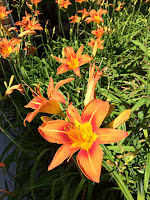
Adaptable Geese

|
||||||||||||||||||||||||||||
|
|
Ferida's Backyard Blog: Whitetail Deer, Tiger Lilies and Adaptable Geese
By Ferida Wolff Young Hungry DeerWe live on a fairly ordinary street, nature-wise. The animals we mostly see in our backyard are squirrels, chipmunks, a groundhog here and there or an unexpected skunk. The birds are more varied with a variety of finches, blue jays, cardinals, sparrows, a woodpecker every now and then. The usual suburban mixture though sometimes we get a surprise. Earlier this year we saw some adult deer making their way in the back of our houses on their way to, well, who knows where. They were in a group of five and looked healthy. This morning we had a deer walk into our yard and slowly make its way into the garden behind our dining room. Most of the time when I see a deer, I am charmed by its understated beauty but this time I gaped at it for another reason; it was young, a fawn on its own, and it seemed malnourished. Its bones were visible along its hide. The mother in me wanted to whip up a nourishing breakfast but I know that feeding a fawn is not the good for the animal. It was moot anyway, as our visitor inspected the hydrangea bush just beyond the window, moved along the back of the house, and was gone. So much of our natural habitat is being shifted into living quarters for humans. There are deer crossing signs on many roads now, with occasional duck or turtle crossing warnings. It would be great if animals and people could live side-by-side peacefully. It would be terrific if we humans could do that too, letting each other live and thrive and express ourselves with respect and tolerance. May none of us be hungry for the basics of a good life. Facts about whitetail deer: https://americanexpedition.us/learn-about-wildlife/whitetail-deer-facts-information-and-photos/
Tigers, Tigers Everywhere! Look at all the tigers! Not the animals – the tiger lilies. They seem to be everywhere, blooming in attention-catching orange. The house on the corner has a yearly display. Gardens up and down the street, around the corner, and through the neighborhood have bursts of orange that are hard to ignore.
I love to anticipate the arrival of my tigers. They are full and beautiful. Best of all, they keep coming back! Sometimes, however, they can take over, spreading into places where other flowers need their own space. A small price to pay, I think, for the beauty they offer.
Life is like a garden, isn’t it? Some of what we encounter is short term, like annuals, while some, like perennials, is lasting. Both kinds of flowers add to the joy and diversity of the garden, even as our varied experiences help us to appreciate the range and complexity of our existence.
A quick review of plants in general:
Tiger Lily info:
Adaptable Geese It was a rainy day. We were just coming home from a round of errands, wondering what the rest of the day would bring, when we saw a family of geese strolling across the wet street. The goose (female), gander (male) and goslings (babies) were completely at ease in the middle of the road. Fortunately, it was a side road and not too busy. We turned to the right, another car edged toward the left, and the goose family slowly, slowly moved toward the curb.
Geese are no strangers to this area. We see lots of them flying in vee formation on their way south. Sometimes they land by a pond or a grass field for a rest. But more of them seem to be making their homes locally now. There are plenty of lakes and streams around to keep them happy and the temperatures generally are not too frigid. But this is new for the Canadian geese that traditionally have flown further south.
Times and temperatures change. The geese, which were recently endangered, are now flourishing thanks to wildlife agencies. And many have made their peace with new environments. They are adaptable.
It's something we can think about. When nature changes, it's not only the geese that must adapt. Temperatures are rising. The ocean is heating up and heading inland, threatening some shore communities and islands. Some areas are becoming parched and fires are more common and difficult to control. Extreme weather patterns are cropping up.
Can we change our habits to help minimize the effect of global climate change? Can we recognize the importance of our behavior on nature? Will we need to be as adaptable as Canadian geese?
Why do some geese stay?
Extreme weather changes:
Observing mild weather:
©2017 Ferida Wolff for SeniorWomen.com More Articles
|
|
||||||||||||||||||||||||||
|
|
||||||||||||||||||||||||||||
SeniorWomenWeb, an Uncommon site for Uncommon Women ™ (http://www.seniorwomen.com) 1999-2025